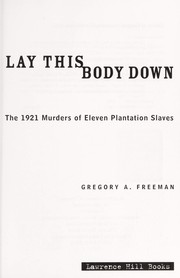Check nearby libraries
Buy this book

"The John S. Williams plantation in Jasper County, Georgia, was operated largely with the labor of slaves. This may not come as a surprise, except that the year was 1921, fifty-six years after the conclusion of the Civil War. Williams was not alone in using "peons" - poor blacks bailed out of local jails, forced to work under threat of whippings, locked up at night, and chased down by bloodhounds if they tried to escape.
But Williams's reaction to a federal investigation was almost unbelievable."--BOOK JACKET. "Williams decided to destroy the evidence. He resolved to kill eleven black men who could testify to the situation on the farm - a farm that would have been considered inhumane even when slavery was legal. To do the job, Williams enlisted the aid of his trusted farm boss, twenty-seven-year-old Clyde Manning, a poor, scared black man, just like those he was told to kill."--BOOK JACKET.
"As this true story unfolds, each detail seems more shocking: a young man forced to methodically kill his friends; his calm, unresisting compliance; men chained together, two by two, weighted down with rocks, and slowly driven to the bridges where they would be thrown over, alive and terrified; men ordered to dig their own graves."--BOOK JACKET.
"The surprises continued in the aftermath, as even a bigoted rural community found that it could not overlook such a heinous crime. A sensational trial ensued, with the entire state gripped by the details revealed in each day's testimony. The trial galvanized national attention and marked a turning point in the treatment of black Americans. Clyde Manning and his fellow peons can truly be said to be the last victims of American slavery."--BOOK JACKET.
Check nearby libraries
Buy this book

Previews available in: English
Subjects
Case studies, true crime, Peonage, Murder, Trials (Murder), Plantation workers, African Americans, Slavery, Crimes against, Bible, juvenile literature, Bible, Bible, history of contemporary events, Social life and customs, Civilization, Juvenile literature, Antiquities, Slaves, united states, African americans, crimes against, Murder, georgiaPeople
Clyde Manning, John S. WilliamsPlaces
Georgia, Jasper CountyShowing 7 featured editions. View all 7 editions?
| Edition | Availability |
|---|---|
|
1
Lay This Body Down: The 1921 Murders of Eleven Plantation Slaves
2002, Chicago Review Press, Incorporated
in English
156976672X 9781569766729
|
zzzz
Libraries near you:
WorldCat
|
|
2
Lay This Body down: the 1921 Murders of Eleven Plantation Slaves
2002, Chicago Review Press, Incorporated
in English
1306011345 9781306011341
|
zzzz
Libraries near you:
WorldCat
|
|
3
Lay This Body Down: The 1921 Murders of Eleven Plantation Slaves
July 2002, Lawrence Hill Books
Paperback
in English
1556524471 9781556524479
|
zzzz
Libraries near you:
WorldCat
|
|
4
Lay This Body Down: The 1921 Murders of Eleven Plantation Slaves
2002, Chicago Review Press, Incorporated
in English
156976686X 9781569766866
|
zzzz
Libraries near you:
WorldCat
|
|
5
Lay This Body Down: The 1921 Murders of Eleven Plantation Slaves
2002, Chicago Review Press, Incorporated
in English
1613742258 9781613742259
|
zzzz
Libraries near you:
WorldCat
|
|
6
Lay This Body Down: The 1921 Murders of Eleven Plantation Slaves
September 1999, Lawrence Hill Books
Hardcover
in English
1556523572 9781556523571
|
zzzz
Libraries near you:
WorldCat
|
|
7
Lay this body down: the 1921 murders of eleven plantation slaves
1999, Lawrence Hill Books
in English
- 1st ed.
1556523572 9781556523571
|
aaaa
Libraries near you:
WorldCat
|
Book Details
Edition Notes
Includes bibliographical references (p. 185-195).
Classifications
The Physical Object
ID Numbers
Source records
Oregon Libraries MARC recordLibrary of Congress MARC record
Internet Archive item record
marc_openlibraries_phillipsacademy MARC record
marc_openlibraries_sanfranciscopubliclibrary MARC record
Better World Books record
Library of Congress MARC record
Library of Congress MARC record
Better World Books record
marc_columbia MARC record
Work Description
The John S. Williams plantation in Georgia was operated largely with the labor of slaves—and this was in 1921, 56 years after the Civil War. Williams was not alone in using “peons,” but his reaction to a federal investigation was almost unbelievable: he decided to destroy the evidence. Enlisting the aid of his trusted black farm boss, Clyde Manning, he began methodically killing his slaves. As this true story unfolds, each detail seems more shocking, and surprises continue in the aftermath, with a sensational trial galvanizing the nation and marking a turning point in the treatment of black Americans.
Excerpts
Community Reviews (0)
Feedback?| July 18, 2024 | Edited by MARC Bot | import existing book |
| June 17, 2022 | Edited by ImportBot | import existing book |
| November 30, 2020 | Edited by MARC Bot | import existing book |
| August 4, 2020 | Edited by ImportBot | import existing book |
| October 25, 2009 | Created by WorkBot | add works page |















